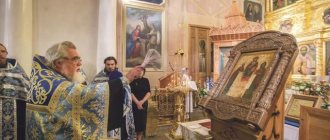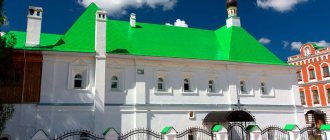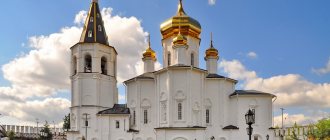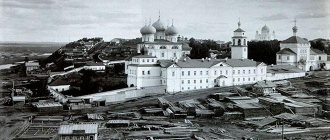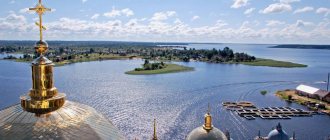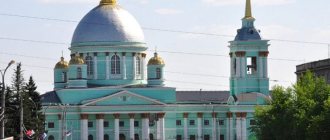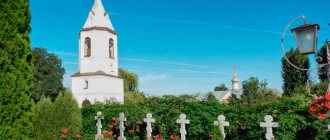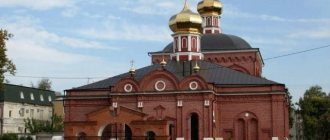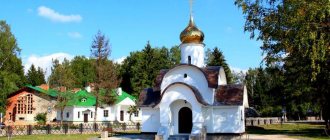| Antoniev-Dymsky Monastery. Photo ok. beginning XXI century |
Antoniev-Dymsky
[1]
monastery in the name of the All-Holy Trinity
of the Tikhvin diocese
- Address: Russia, 187613, Leningrad region, Boksitogorsky district, Bolshedvorskoe village, Krasny Bronevik village, Galichno village
- Tel.
- Directions: from St. Petersburg by bus from the bus station on the Obvodny Canal embankment in the direction of Boksitogorsk or Pikalevo, stop. “Galichino”, then 3 km on foot
- On the map: Yandex.Map, Google map
Located 15 km southeast of Tikhvin and 20 kilometers from Boksitogorsk, on a hill near Lake Dymskoye.
| St. Anthony Dymsky. In the background is the Antoniev-Dymsky Monastery he founded. Icon con. XVII century (MIIRK) |
The first centuries of the monastery's history
One of the oldest monasteries in North-West Russia, the monastery was probably founded in the first half of the 13th century [2] by the Monk Anthony of Dymsky, who settled in a secluded place on the shore of Lake Dymsky, dug out a cave, set up a cell and began to struggle in fasting and prayer. When the brethren gathered, they built a two-story wooden church in the name of St. Anthony the Great [3]. Soon, “for the common repose of the brethren,” another church was built, “warm with a meal,” in honor of the Nativity of John the Baptist. The charter for the creation of the monastery was granted by the blessed prince Alexander Yaroslavich Nevsky [4], in connection with his miraculous healing through the prayers of St. Anthony [5]. Upon the repose of Saint Anthony, his relics were buried in the church he created.
In the 14th century [6] the incorruptible relics of the venerable founder were found in the monastery. It was probably on the day of the discovery of the relics that the celebration of the memory of St. Anthony was established on January 17.
In 1409, the monastery was ravaged and burned by the Tatars of Edigei, but before the destruction the brethren again buried the relics (“let them not be desecrated by the enemies”), and all the church utensils, bells and shrines were lowered to the bottom of Lake Dymskoye. Then the monastery was restored; at the end of the 16th century, the inhabitants of the devastated Valaam monastery found refuge here, bringing with them the Valaam Rule. But in 1611 the monastery was destroyed again - now by the Swedes Delagardi [7].
Thanks to the donations of Tsar Mikhail Feodorovich, in 1626 the “monastery on Dymy” was renewed and the inhabitants of the Valaam monastery, destroyed by the Swedes, were resettled there. In 1655-1656, through the efforts of the builder monk Philaret, a cathedral was built in the monastery in the name of St. Anthony the Great with chapels in the name of St. Nicholas the Wonderworker and in honor of the Kazan Icon of the Mother of God. Consecrated on January 17, 1656, the cathedral became the first stone church of the monastery.
In 1687, the monastery burned down, but was then rebuilt. In 1690, the monastery was assigned to the Novgorod St. Sophia Cathedral. It is also listed as such in the charter of Tsars Ivan Alekseevich and Peter Alekseevich dated June 21, 1692.
| Anthony's Dymsky Monastery. Lithograph 1851 |
Synodal period
In 1744, a gilded wooden tomb was built over the place where the relics of the founder of the monastery were hidden by the St. Petersburg merchant Kalitin, who was healed by the Monk Anthony from a long serious illness.
Until 1764, the Antoniev-Dymsky Monastery owned 120 acres of land, and 111 peasants were assigned to it. During the secularization reform of that year, the monastery was abolished; clergy of the Novgorod diocese lived in its premises. The cathedral church became a parish church and white priests served there for 30 years.
At the end of the 18th century, in the former monastery, Father Abraham Ksenifontov built a new wooden church in honor of the Nativity of John the Baptist, consecrated on June 23, 1783 by Archimandrite Euthymius of the Tikhvin Great Monastery. In the early 1790s, Father Abraham began “finishing” the upper church in the cathedral in the name of the Life-Giving Trinity.
On September 1, 1794, at the request of Archimandrite Ignatius of the Tikhvin Great Monastery, by decree of Metropolitan Gabriel of Novgorod and St. Petersburg, the monastery was restored as a third-class dormitory, and residents of the Tikhvin Monastery, numbering about 30 people, were transferred to it. The monastery began to be managed by builders. The 20-point charter of the revived monastery was drawn up by Metropolitan Gabriel himself, sending it on October 11, 1795. In addition to annual maintenance, the monastery also used a lake, arable land, vegetable gardens, meadow land and a firewood forest. In total, the monastery's income did not exceed 110 rubles per year. The revival of the monastery was supported by Emperor Pavel Petrovich, who on April 9, 1799 donated 2,000 pine trees from the treasury to repair the monastery.
In February 1806, abbot Gerasim (Gaidukov) undertook reconstruction, and in 1840, repair of the monastery Kazan Cathedral, which was reconsecrated in the name of the Holy Trinity. In 1839, under Abbot Amphilochia, the monastery was surrounded by a stone fence with four towers, the Holy Gates and a chapel. In 1840, under Abbot Ilaria, a one-story fraternal building was built, in 1846 - a two-story abbot's building with a fraternal refectory, kitchen and prosphora, in 1849 - a two-story pilgrim building, and in 1850 - utility buildings, glaciers, and a kvass brewery. Thanks to private donations, as well as a gift from the Optina Monastery, by the middle of the 19th century, the monastery had accumulated a small library (about 300 books). The archives of the monastery, according to the inventory of the 1860s, have been preserved only since 1794. In 1867, a two-story building of a hospice house was built.
By the end of the 19th century, the monastery still had two churches - the Trinity Cathedral and the Church of the Baptist. There was a parish school at the monastery, where children from the surrounding villages studied. The income was contributed by the annual 4-day St. Anthony's Fair, which took place in celebration of the day of memory of St. John the Baptist and the repose of St. Anthony of Dymsky. On this day, June 24, after the Divine Liturgy, a religious procession was held from the monastery to Lake Dymskoye.
Destruction during the Soviet years
The penultimate abbot of the monastery, Methodius, according to the report of the dean, Archimandrite Anthony (Demyansky), “turned against himself the surrounding population, which threatened with arson” [8]. After 1919, the monastery was closed and the brethren were evicted. For decades, local residents have been telling the story of how an armored car was sent from Tikhvin, from which the revolutionaries announced the closure of the monastery, perpetuating their “feat” by renaming this place to the village of Krasny Bronevik. According to the stories of residents of surrounding villages, after the closure of the monastery, one of its inhabitants, Hieromonk Job, hid in nearby villages, secretly performing baptisms and funeral services. In 1921, the county social security service placed a “Shelter for the crippled and the elderly” in the monastery premises. In 1929, a brick production commune with the same name, “Red Armored Car,” was formed in the former monastery. However, “production” consisted of dismantling the monastery walls and towers into bricks for sale. As a result of the “brick production”, almost all the monastery buildings were gradually dismantled. In the 1920s, the Church of the Nativity of John the Baptist was closed and then destroyed. However, the Trinity Cathedral is mentioned as operating back in 1931 as a parish church - pilgrims from Tikhvin came here when all the churches in the city were closed. At the end of the 1930s, the cathedral was also closed.
After the Great Patriotic War, a school for tractor drivers was organized in the only remaining abbot building and hotel. At the same time, the monastery cemetery was also destroyed. Later, a psychiatric institution was located in the monastery. The main cathedral of the monastery was used as a warehouse, and in 1956-1961 it was dismantled. In recent decades, the remains of the monastery were transferred to the Boksitogorsk Glinozem plant, and a factory sanatorium was located in the former monastery hospice house.
Renaissance
By the beginning of the 1990s, all that remained of the previous buildings of the monastery were the skeleton of the cathedral bell tower, the empty two-story abbot building, the two-story building of the hospice house, the building of the parochial school, and several wooden outbuildings. The beginning of the resumption of the monastery was the installation in the summer of 1994, through the efforts of the parishioners of the Peter and Paul Church in the village of Somina, of a cross on the shore of Lake Dymskoye. On January 30, 1997, representatives of the Glinozem plant handed over the keys to the hospice building - the only building preserved in operational condition - to the inhabitants of the Tikhvin Assumption Great Monastery, and on October 30 of the same year, the Antoniev-Dymsky Monastery was reopened as a registered monastery of the Tikhvin monastery.
Divine services were initially resumed in the house chapel in the former hospice house. In 2000, a new refectory church was built, and restoration of the Trinity Cathedral began. On June 16, 2001, during excavations at the site of the cathedral, the relics of St. Anthony of Dymsky were discovered, first placed in the Assumption Cathedral of the Tikhvin Monastery, and on June 1, 2008, returned to the reviving Dymsky monastery.
By a synodal decision of October 6, 2008, the monastery was reopened as an independent one. The first bishop's service known in the history of the monastery was performed there by Bishop of Gatchina Ambrose (Ermakov) on March 14 and 15, 2009 [9]. On the 10th anniversary of the discovery of the relics of the founder of the monastery, a stone chapel in the name of St. Anthony of Dym was built opposite the monastery lake, and on July 7, 2011, it was consecrated. In 2012, a monastery courtyard was opened at the St. Petersburg Church of the Intercession on Borovaya. Since by 2013 the population of the village of Krasny Bronevik consisted almost entirely of monks and people who work for the monastery, the question arose of renaming the settlement, perpetuating the “dispersal” of the monastery of the early 20th century [8].
| Temple of Varlaam of Khutyn Antony-Dymsky Monastery. Photo ok. beginning XXI century |
Temples, architecture
Varlaamo-Khutyn Temple
The church in the name of St. Varlaam Khutynsky at the refectory was converted from a boiler room building. The minor consecration of the temple took place in 2001.
Anthony's-Dymskaya Chapel
A stone chapel in the name of St. Anthony of Dymsky was built on the shore of Lake Dymsky in 2011 and consecrated on July 7 of that year.
Lost
Anthony's Temple
The original churches of the monastery were erected under the Venerable Anthony of Dymsky in the 13th century. The first was the two-story wooden church of St. Anthony the Great. The upper church of this temple was consecrated either in the name of St. Nicholas the Wonderworker (according to the early edition of the life of St. Anthony of Dymsky), or in honor of the Intercession of the Mother of God (according to the later edition). The time of the loss of this temple is unknown.
The first stone cathedral of the monastery, built in 1655-1656, was also dedicated to St. Anthony the Great, but was later reconsecrated in honor of the Kazan Icon of the Mother of God, and then in the name of the All-Holy Trinity.
Church of the Nativity of John the Baptist
Soon after the establishment of the monastery, under the Venerable Anthony of Dymsky in the 13th century, “for the common repose of the brethren,” the second church of the monastery was built, “warm with a meal,” in honor of the Nativity of John the Baptist. The time of the loss of this temple is unknown.
At the end of the 18th century, a new wooden church was built in the monastery, which was abolished at that time, in honor of the Nativity of John the Baptist, consecrated on June 23, 1783 by Archimandrite Euthymius of the Tikhvin Great Monastery. This church was closed in the 1920s and then destroyed.
Trinity (formerly Antonievsky, Kazan) Cathedral
The monastery cathedral was erected in 1655-1656 through the efforts of the builder, monk Philaret. The cathedral became the first stone building in the monastery. Initially, the cathedral was consecrated in the name of St. Anthony the Great with chapels in the name of St. Nicholas the Wonderworker and in honor of the Kazan Icon of the Mother of God. Then the Kazan throne became the main one, and the chapel of Anthony the Great was built over the tomb of St. Anthony of Dymsky).
As a result of reconstruction in February 1806 and repairs in 1840, the second floor of the cathedral was built with the main altar consecrated in the name of the Holy Trinity (on the right, consecrated on February 15, 1806), and with the chapel of St. Anthony of Dymsky (on the left, consecrated on February 24, 1806). The first tier of the cathedral now consisted of the chapels of the Kazan Icon of the Mother of God (consecrated on August 28, 1849) and St. Anthony the Great (consecrated on July 10, 1850). As a result, the cathedral became five-domed and four-altared with a two-tier bell tower. It was closed at the end of the 1930s, and dismantled in 1956-1961. Since the early 2000s, restoration work has been carried out.
Hermitages and farmsteads
- St. Petersburg Compound:
- Intercession Church on Borovaya
Founder of the ancient monastery
Researchers claim that no historical monuments have survived confirming the existence of the monastery earlier than the 16th century, and, nevertheless, tradition attributes its founding to the Monk Anthony, who settled in the Novgorod lands around 1240. They even say that even before the revolution, a charter granted by Prince Alexander Nevsky was kept in the monastery, but then it disappeared without a trace, like much of what the monks revered as their priceless relics.
The same legend says that the founder of the monastery reposed in the Lord in 1274, and his body was buried near the choir, the church of St. Anthony the Great that he built. When the grave was opened a century later, the relics were found incorrupt and emanating a fragrance, after which they were placed in an open reliquary located in the church.
Abbots
- St. Anthony Dymsky (XIII century)
- …
- Gerasim (Gaidukov) (mentioned February 1806)
- …
- Amphilochius (mentioned 1839) abbot.
- Ilarius (mentioned 1840) abbot.
- …
- Methodius (mentioned 1913)
- Feoktist (Kirillov) (last abbot) abbot.
1919 - 1997 - closure and desecration
Builders of the monastery
- Bartholomew (Kovalyov) (mentioned March 2001)
- Nikita (Petukhov) (2000s) hierodiac.
Abbots of the monastery
- Ignatius (Buzin) (October 6, 2008 - October 23, 2014)
- Adrian (Dementyev) (from October 23, 2014)
Soviet times and years of perestroika
Nevertheless, despite all the troubles, the main church of the monastery, Trinity Cathedral, continued to function until the end of the 30s as a parish church. During the Great Patriotic War it was destroyed and was not restored in the post-war years. Since 1945, two miraculously preserved buildings - the cell building and the hotel building - housed a school for tractor drivers.
When, in 1952, the territory of the monastery came under the jurisdiction of the administration of the newly formed Boksitogorsk district, it was transferred to the local psychiatric hospital. Subsequently, the management of the alumina refinery won back the areas they liked from the doctors, which disposed of them until 1997, when, in the wake of perestroika, everything that remained by that time from the monastery was returned to the St. Petersburg diocese. The newly formed monastery was assigned as a metochion to the Tikhvin Monastery.
Svytyn
- cancer with the relics of St. Anthony Dymsky
- St. iron hat Anthony of Dymsky - in the pre-revolutionary years it was kept next to the wooden gilded shrine of St. Anthony in Trinity Cathedral; weighed more than 3 kg.
- list of the Kazan Icon of the Mother of God - kept in the monastery cathedral, especially revered in the pre-revolutionary years, location after the revolution is unknown
Statistics
- 1794 - during the restoration of the monastery, the inhabitants of the Tikhvin Monastery, numbering approx. 30 people [10]
- shortly before 1917 - 55 inhabitants [11]
- March 2001 - Antoniev-Dymsky Monastery (attached to the monastery of the Tikhvin Dormition Monastery) - 2 inhabitants [10]
The fate of the monastery in the 18th and 19th centuries
The 18th century, which soon arrived, brought little joy to the inhabitants of the Anthony-Dymsky Monastery. If it managed to somehow survive the first half (albeit with heavy losses from the recruitment of Peter I), then under Empress Catherine II, who pursued a policy of secularization (seizure) of monastic lands, it was abolished. The monks were sent to other monasteries, and the monastery church was made a parish church. Only at the very end of the century its activity was resumed.
The 19th century turned out to be much happier for the monastery. Starting with Emperor Paul I, all subsequent rulers provided him with patronage in one form or another. This made it possible to carry out a large volume of construction work, erecting stone buildings in place of the previous wooden structures. The monastery received ownership of significant land, as well as fishing grounds on Lake Dymskoye.
Literature
- [Inventory of Anthony's Dymsky Monastery 1682, 1689], Archive of St. Petersburg FIRI RAS
, f. 132, op. 2, units No. 609. - [Inventory of Anthony's Dymsky Monastery 1583], VOIDR
, 1850, book. 6, p. 89. - John, Hierom., Historical and statistical description of the Dymsky Monastery
, St. Petersburg, 1861. - Pavlovsky A. A., General illustrated guide to monasteries and holy places of the Russian Empire and Mount Athos
, B. m., 1907. - Mordvinov I.P., “Letter to the editor”, Novgorod North
, 1915, No. 33. - Mordvinov I.P., Old Tikhvin and Nagornoye Obonezhye
, Tikhvin, 1925. - Milchik M.I., Varakin E.P., “Iconography of the wooden Anthony Monastery and its graphic reconstruction”, Folk Architecture: Collection.
scientific tr. , Petrozavodsk, 1992, p. 141-154. - Belobrova O. A., “Two editions of the life of Anthony of Dymsky”, TODRL
, 1997, vol. 50, p. 281-292. - Belovolov G., priest, “Reverend Anthony of Dymsky - disciple of Varlaam Khutynsky”, Sofia.
Novgorod , 1998, No. 2, 32-34. - Rumyantseva I., Kudryashev S., Monasteries of the St. Petersburg Diocese
, St. Petersburg, 2000, p. 72-79.
The atrocities of Khan Edigei
What follows is the story that in 1409 the male Orthodox monastery, founded by the Monk Anthony, was invaded by the Tatar Khan Edigei and was completely destroyed. However, foreseeing misfortune, the monks securely hid the saint’s relics in the ground, and all the valuables, including the iron cap and chains with which he tormented the flesh, were lowered to the bottom of Lake Dymskoye.
The bells and gilded crosses of the domes were also buried there from their adversaries. It must be admitted that such information raises some doubts, since, according to the chronicles, Khan Edigei did not reach the Novgorod lands, but nevertheless the legend is quite in tune with the folk epic and has been living for many centuries.
Life
The worldly name of the saint has not been preserved. It is only known that he came from a pious Novgorod family ; the names of his parents also did not remain in history. Different sources indicate the year of birth of the ascetic as 1157 or 1206.
Useful materials
Already from his youth, Anthony showed a penchant for monasticism and sought to leave the world with its temptations and temptations. In 1225, Anthony chose the Spassky Monastery in Khutyn for tonsure, and came to Abbot Varlaam, already known for his holiness.
According to some sources, the perspicacious elder, seeing Anthony’s spiritual gifts, tonsured him almost immediately; according to others, about 2 years passed before Anthony’s tonsure. The monk was given a name in honor of St. Anthony the Great.
It is more or less reliably known that the humble, meek Anthony became one of the close students of the abbot , St. Varlaam. Some authors believe that this caused jealousy and envy of the brethren, from which the ascetic had to endure a lot of persecution and insults.
About 10 years after his tonsure, he even had to leave the monastery: Varlaam sent him to Constantinople, to Patriarch Athanasius, on some monastic affairs. However, according to other sources, Anthony was chosen for this work by the brethren for his virtues.
One way or another, Anthony spent 5 whole years in Constantinople and returned to his homeland shortly before the death of his elder, St. Varlaam, in 1243
It was to him that Varlaam entrusted the monastery after his death. But Anthony's abbess did not last even a year. soon left the monastery , which may have been provoked by a new conflict with the brethren, but, of course, corresponded to the ascetic’s desire for a solitary life.
Income
The monastery was a three-class monastery and received an annual allowance of 85.71 rubles. His annual income in total did not exceed 110 rubles. The Antoniyevo-Dymsky Monastery used vegetable gardens, meadow land, arable land, and wood timber. And the lake, to the shores of which the Monk Anthony once came in search of prayerful solitude, also belonged to him. The income was contributed by the four-day St. Anthony's Fair held every year to celebrate the day of memory of John the Baptist.
The number of inhabitants, starting from thirty monks of the Tikhvin monastery, who settled here in 1794, increased to fifty-five by 1917. The report of Archimandrite Anthony (Demyansky) dated 1913 states that all the brethren, with the exception of a few people, behaved badly. Most of the hieromonks had families, and the abbot turned the surrounding population against himself, and people threatened to set them on fire.
The last abbot of the monastery, who urgently replaced Father Methodius, indicated in the report, was Abbot Theoktist.
Veneration of the Reverend
The main shrine of the monastery is the relics of its founder, St. Antonia. Many pilgrims also strive to visit Dymskoye Lake; there is even a version that the name of the lake comes from the fact that it is covered with the prayers of the monk, as if with incense smoke.
In pre-revolutionary times, visiting people, no matter what the weather or season, plunged into the waters of the lake, believing in their healing power and, by faith, receiving what they asked for. They say that the font itself on the lake was built by a merchant who received healing here.
Now, according to the official website of the monastery, the largest number of pilgrims is for the Feast of Pentecost, as well as for July 7, the day of remembrance of the Prophet John the Baptist and St. Antonia.
Renewal of the monastery
On Dymskoe Lake, near the stone where, according to legend, St. Anthony prayed, a four-meter wooden cross was installed in 1994. This event was timed to coincide with the 770th anniversary of the death of Anthony and the bicentenary of the second renewal of the monastery in 1794.
On October 30, 1997, the Anthony-Dymsky Monastery was transferred to the Russian Orthodox Church and was assigned to the Tikhvin Monastery as a monastery.
In 2000, restoration of the main cathedral began, and work continues to this day. Through the efforts of Abbot Euthymius, abbot of the Tikhvin Monastery, in 2001 the second discovery of Anthony’s relics took place in the monastery. Until 2008, they were in the Assumption Cathedral of the Tikhvin Monastery, and then were returned to the Trinity Anthony-Dymsky Monastery.
At the end of the nineties of the twentieth century, a wooden chapel of St. Anthony was erected on Dymskoye Lake; in 2011 it was replaced by a stone chapel. In addition, a bathhouse was built and the shore was developed.
On October 6, 2008, the Anthony-Dymsky Monastery received the status of an independent monastery, and Abbot Ignatius was appointed its abbot.
XVI-XVII centuries
Since 1585, after the Valaam monastery was devastated by the Swedes in 1578, its monks moved to the Anthony-Dymsky Monastery. Valaam communal traditions have been preserved here. In 1618, the monks were transferred to the Vasilyevsky monastery on Volkhov.
In 1611, the monastery was destroyed by the Swedes. The troops of Jacob Delagardie were unable to take the Tikhvin Assumption Monastery by siege and attacked Dymskaya. The brethren of the unfortified monastery were unable to offer resistance and dispersed into the surrounding forests. Cells and temples were burned.
With the blessing of Patriarch Filaret, in 1626, Tsar Mikhail Fedorovich ordered the restoration of the Anthony-Dymsky Monastery. And during the reign of Alexei Mikhailovich, in 1655, the first stone temple was built in the monastery through the efforts of Abbot Philaret.
In 1687, the Dymsky Monastery burned down and was then rebuilt.
In the charter of Tsars Peter Alekseevich and Ivan Alekseevich dated June 21, 1692, the monastery was listed as attached to the Sophia House.
ANTONYEV DYMSKY MONASTERY
[Antonov on Dymekh], since 1997 the monastery of the Tikhvin Great Husband. monastery of the St. Petersburg diocese, in the Tikhvin district of the Leningrad region. The source of information about the foundation of A.D. m. is the life of St. Anthony Dymsky, which came in 2 editions: early, compiled in the end. XVII century, probably in A.D. m. using local legends (BAN. Mordvin. No. 11) and later, created in A.D. m. at the end. XVIII - beginning XIX century, according to researchers, is a reworking of an earlier edition based on the model of “The Life of Our Venerable Father Theodosius ordained Sumorin, Totemsky.”
Antoniev Dymsky Monastery. Lithography. 1851 Antoniev Dymsky Monastery. Lithography. 1851
According to both editions, A.D.M. was founded c. 1243, when St. Anthony, having settled in a secluded place on the shore of Lake Dymsky, dug out a cave, set up a cell and began to labor in fasting and prayer. When the brethren gathered, they built a 2-story wooden church. in the name of St. Anthony the Great (according to the early edition, the upper center was consecrated in honor of St. Nicholas the Wonderworker, according to the later edition - in honor of the Intercession of the Mother of God). Soon, “for the common repose of the brethren,” another temple was built, “warm with a meal,” in honor of the Nativity of John the Baptist. a later edition reports that the charter for the creation of the monastery was granted to St. blgv. book Alexander Yaroslavich Nevsky.
According to the later edition of the life, in 1409 A.D. m. was ravaged and burned by the Tatars. The relics of St. Anthony, found incorrupt in 1370, before the destruction of the monastery, the brethren again interred the earth, “so that they will not be mocked by their enemies.” The monks lowered all the church utensils, bells and shrines to the bottom of Lake Dymsky. A later edition also reports that in 1611 the monastery was devastated by the Swedes, but thanks to the donations of Tsar Mikhail Feodorovich, it was restored in 1626; the inhabitants of the Valaam monastery, which also suffered greatly from the Swedes, were resettled there. In the early edition of the life, the invasions of the Tatars and Swedes are not mentioned; it is said that ancient information about the monastery was not preserved “due to great oblivion and negligence ... and from former fires and all sorts of military people’s riots and finds, and from their own, living in the monastery, all sorts of poverty and simplicity” (Belobrova, p. 289). I.P. Mordvinov considered the news of the invasions and devastation of the monastery contained in the later edition to be legendary, since “there are no indications either in the chronicles or in other legends... no legends in Tikhvin”; if A.D. m. “after the invasion of the Swedes was quite suitable for the residence of the monks” resettled from the Valaam monastery, it means that it “was not subject to ruin.” In 1687, the A.D. m. burned down and was then rebuilt.
In 1690, A. D. M. was assigned to the Novgorod St. Sophia Cathedral. Until 1764, the monastery owned 120 dessiatines. land, 111 peasants were assigned to him. It was abolished in 1764; clergy of the Novgorod diocese lived in its premises. 1 Sep. 1794 at the request of Archimandrite. Tikhvin Bolshoi husband. Monastery of Ignatius by decree of Metropolitan. The Novgorod and St. Petersburg Gabriel (Petrov) A.D. M. was restored as a dormitory, and residents of the Tikhvin Monastery (about 30 people) were transferred to it. The monastery began to be managed by builders. The 20-point charter of the revived monastery was drawn up by Metropolitan himself. Gabriel (Petrov), sending it a year later - October 11. 1795 The restored monastery was 3-class, received an annual maintenance of 85 rubles. 71 k., in total his income did not exceed 110 rubles. in year. A. D. M. also used the lake, arable land, vegetable gardens, meadow land and firewood.
K con. XIX century there were 2 churches in A.D.M. Cathedral in honor of the Kazan Icon of the Mother of God with chapels of St. Nicholas the Wonderworker and St. Anthony the Great, placed over the tomb of St. Anthony of Dymsky, was erected in 1655/56 through the efforts of the builder of the monastery. Philareta. As a result of reconstruction (February 1806) and repairs (1840), the 2nd floor of the cathedral was built with the main altar, consecrated in the name of the Holy Trinity, and with the chapel of St. Anthony Dymsky. The 1st tier of the cathedral now consisted of 2 chapels: the Kazan Icon of the Mother of God (consecrated on August 28, 1849) and St. Anthony the Great (consecrated July 10, 1850).
In con. XVIII century A wooden church was built in honor of the Nativity of St. John the Baptist, consecrated on June 23, 1783 by Archimandrite. Tikhvin Great Monastery Euthymius. In 1839, under the abbot. Amphilochia Monastery was surrounded by a stone fence with 4 towers, the Holy Gate and a chapel. In 1840, under abbot. Ilaria, a 1-story fraternal building was built, in 1846 - a 2-story abbot's building with a fraternal refectory, kitchen and prosphora, in 1849 - a 2-story pilgrim building, in 1850 - utility buildings, glaciers, and a brewery.
The Kazan Icon of the Mother of God was especially revered in the monastery (the location after 1917 is unknown); next to the wooden gilded shrine of St. Anthony's iron hat (weighing more than 3 kg) was kept in the Trinity Cathedral. Every year on June 24, the day of the saint’s repose, a religious procession was held from the monastery to Lake Dymskoye. Thanks to private donations, as well as a gift from Optina, it is empty. to mid. XIX century A small library (about 300 books) gathered in the A.D.M. Archive of the monastery, according to the inventory of the 60s. XIX century, preserved only since 1794
After 1919, the A.D.M. was closed and the brethren were evicted. According to the stories of residents of the surrounding villages, after the closure of the monastery, one of its inhabitants, Jerome. Job hid in nearby villages, secretly performing baptisms and funeral services. For some time, the premises of the monastery housed a psychiatric hospital, then the Boksitogorsk Alumina plant and a sanatorium-preventorium. In the 20s XX century was closed and then destroyed. Nativity of St. John the Baptist; in the end 30s XX century closed, 1956-1961 The Holy Trinity Cathedral was dismantled, as well as the walls and towers of the monastery. Only the hospital building and the skeleton of the bell tower have survived.
The beginning of the resumption of the monastery was the establishment in 1994, through the efforts of the parishioners of the Peter and Paul Church. With. Somina cross on the shore of Lake Dymskoye. 30 Jan In 1997, representatives of the Glinozem plant handed over the keys to the hospice building to the inhabitants of the Tikhvin Great Monastery. Oct 30 1997 A.D.M. was resumed as an assigned monastery of the Tikhvin Monastery. In March 2001, there were 2 inhabitants in A.D. m., the builder was mon. Bartholomew (Kovalyov). It was planned to erect a chapel on the shore of Lake Dymskoye, as well as a temple in honor of the Kazan Icon of the Mother of God on the territory of the monastery.
Arch.: [Inventory of A.D. m. 1682, 1689] // Archive of St. Petersburg Institute of Radiology of the Russian Academy of Sciences. F. 132. Op. 2. Unit No. 609.
Source: [Inventory of the monastery of 1583] // VOIDR. 1850. Book. 6. P. 89.
Lit.: John, Hierom. Historical and statistical description of the Dymsky Monastery. St. Petersburg, 1861; Pavlovsky A. A. General illustrated guide to monasteries and holy places of the Russian Empire and Mount Athos. B. m., 1907; Mordvinov I.P. Letter to the editor // Novgorod North. 1915. No. 33; aka. Old Tikhvin and Nagornoye Obonezhye. Tikhvin, 1925; Milchik M.I., Varakin E.P. Iconography of the wooden Anthony Monastery and its graphic reconstruction // Folk architecture: Collection. scientific tr. Petrozavodsk, 1992. pp. 141-154; Belobrova O. A. Two editions of the life of Anthony of Dymsky // TODRL. 1997. T. 50. P. 281-292; Belovolov G., priest. Reverend Anthony of Dymsky - disciple of Varlaam Khutynsky // Sofia. Novgorod, 1998. No. 2. P. 32-34; Rumyantseva I., Kudryashev S. Monasteries of the St. Petersburg diocese. St. Petersburg, 2000. pp. 72-79.
D. B. Kochetov
